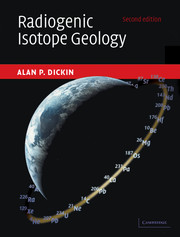Book contents
- Frontmatter
- Contents
- Preface
- Acknowledgements
- 1 Nucleosynthesis and nuclear decay
- 2 Mass spectrometry
- 3 The Rb–Sr method
- 4 The Sm–Nd method
- 5 Lead isotopes
- 6 Isotope geochemistry of oceanic volcanics
- 7 Isotope geochemistry of continental rocks
- 8 Osmium isotopes
- 9 Lu–Hf and other lithophile isotope systems
- 10 K–Ar and Ar–Ar dating
- 11 Rare-gas geochemistry
- 12 U-series dating
- 13 U-series geochemistry of igneous systems
- 14 Cosmogenic nuclides
- 15 Extinct radionuclides
- 16 Fission-track dating
- Index
11 - Rare-gas geochemistry
- Frontmatter
- Contents
- Preface
- Acknowledgements
- 1 Nucleosynthesis and nuclear decay
- 2 Mass spectrometry
- 3 The Rb–Sr method
- 4 The Sm–Nd method
- 5 Lead isotopes
- 6 Isotope geochemistry of oceanic volcanics
- 7 Isotope geochemistry of continental rocks
- 8 Osmium isotopes
- 9 Lu–Hf and other lithophile isotope systems
- 10 K–Ar and Ar–Ar dating
- 11 Rare-gas geochemistry
- 12 U-series dating
- 13 U-series geochemistry of igneous systems
- 14 Cosmogenic nuclides
- 15 Extinct radionuclides
- 16 Fission-track dating
- Index
Summary
The elements known as the rare, inert or noble gases possess unique properties that make them important in isotope geology. The low abundance of these rare gases allows them to sensitively record several types of nuclear process, even including rare nuclear-fission reactions. (In contrast, the relatively larger abundance of other fission-product nuclides such as the ‘rare’ earths swamps fissiogenic production.) Another property of these gases is their inertness, which allows unique insights into the Earth's interior because of their lack of interaction with other materials. Finally, as isotopic tracers, rare gases can give information about the degassing history of the mantle, the formation of the atmosphere, and mixing relationships between different mantle reservoirs.
Helium
Helium has two isotopes, 4He and 3He. The former was recognised by Rutherford (1906) to be the α-decay product of actinide elements, and hence comprised the first radiometric dating method. However, the great diffusivity of helium made the method very susceptible to thermal disturbance, and it has therefore been abandoned in all but the most specialised applications (e.g. Wernicke and Lippolt, 1993).
Non-radiogenic 3He was first discovered in nature by Alvarez and Cornog (1939). Alvarez and Cornog estimated (using a cyclotron) that atmospheric helium had a 3He/4He ratio ten times greater than that of natural oil-well gases from the Earth's crust. Aldrich and Nier (1948) confirmed this observation by mass-spectrometric measurements, and determined atmospheric and well-gas 3He/4He ratios of about 1.2 × 10-6 and 1 × 10-7, respectively.
- Type
- Chapter
- Information
- Radiogenic Isotope Geology , pp. 291 - 323Publisher: Cambridge University PressPrint publication year: 2005



